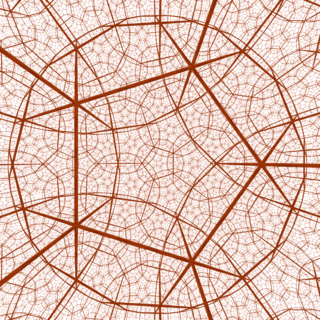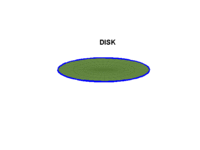In geometry and complex analysis, a Möbius transformation of the complex plane is a rational function of the form

In mathematics, a hyperbolic space is a homogeneous space that has a constant negative curvature, where in this case the curvature is the sectional curvature. It is hyperbolic geometry in more than 2 dimensions, and is distinguished from Euclidean spaces with zero curvature that define the Euclidean geometry, and elliptic geometry that have a constant positive curvature.

In mathematics, a discrete subgroup of a topological group G is a subgroup H such that there is an open cover of G in which every open subset contains exactly one element of H; in other words, the subspace topology of H in G is the discrete topology. For example, the integers, Z, form a discrete subgroup of the reals, R, but the rational numbers, Q, do not. A discrete group is a topological group G equipped with the discrete topology.
In mathematics, a Fuchsian group is a discrete subgroup of PSL(2,R). The group PSL(2,R) can be regarded equivalently as a group of isometries of the hyperbolic plane, or conformal transformations of the unit disc, or conformal transformations of the upper half plane, so a Fuchsian group can be regarded as a group acting on any of these spaces. There are some variations of the definition: sometimes the Fuchsian group is assumed to be finitely generated, sometimes it is allowed to be a subgroup of PGL(2,R), and sometimes it is allowed to be a Kleinian group which is conjugate to a subgroup of PSL(2,R).
In mathematics, a space form is a complete Riemannian manifold M of constant sectional curvature K. The three obvious examples are Euclidean n-space, the n-dimensional sphere, and hyperbolic space, although a space form need not be simply connected.
In mathematics, more precisely in topology and differential geometry, a hyperbolic 3–manifold is a manifold of dimension 3 equipped with a hyperbolic metric, that is a Riemannian metric which has all its sectional curvatures equal to -1. It is generally required that this metric be also complete: in this case the manifold can be realised as a quotient of the 3-dimensional hyperbolic space by a discrete group of isometries.

In mathematics, a Kleinian group is a discrete subgroup of PSL(2, C). The group PSL(2, C) of 2 by 2 complex matrices of determinant 1 modulo its center has several natural representations: as conformal transformations of the Riemann sphere, and as orientation-preserving isometries of 3-dimensional hyperbolic space H3, and as orientation preserving conformal maps of the open unit ball B3 in R3 to itself. Therefore, a Kleinian group can be regarded as a discrete subgroup acting on one of these spaces.
In mathematics, Mostow's rigidity theorem, or strong rigidity theorem, or Mostow–Prasad rigidity theorem, essentially states that the geometry of a complete, finite-volume hyperbolic manifold of dimension greater than two is determined by the fundamental group and hence unique. The theorem was proven for closed manifolds by Mostow (1968) and extended to finite volume manifolds by Marden (1974) in 3 dimensions, and by Prasad (1973) in all dimensions at least 3. Gromov (1981) gave an alternate proof using the Gromov norm.
In mathematics, a Bianchi group is a group of the form
In differential geometry, a subfield of mathematics, the Margulis lemma is a result about discrete subgroups of isometries of a non-positively curved Riemannian manifolds. Roughly, it states that within a fixed radius, usually called the Margulis constant, the structure of the orbits of such a group cannot be too complicated. More precisely, within this radius around a point all points in its orbit are in fact in the orbit of a nilpotent subgroup.
In the theory of Riemann surfaces and hyperbolic geometry, the triangle group (2,3,7) is particularly important. This importance stems from its connection to Hurwitz surfaces, namely Riemann surfaces of genus g with the largest possible order, 84(g − 1), of its automorphism group.
In mathematics, more precisely in group theory and hyperbolic geometry, Arithmetic Kleinian groups are a special class of Kleinian groups constructed using orders in quaternion algebras. They are particular instances of arithmetic groups. An arithmetic hyperbolic three-manifold is the quotient of hyperbolic space by an arithmetic Kleinian group. These manifolds include some particularly beautiful or remarkable examples.
In mathematics, the concept of a relatively hyperbolic group is an important generalization of the geometric group theory concept of a hyperbolic group. The motivating examples of relatively hyperbolic groups are the fundamental groups of complete noncompact hyperbolic manifolds of finite volume.
In mathematics, specifically in group theory, two groups are commensurable if they differ only by a finite amount, in a precise sense. The commensurator of a subgroup is another subgroup, related to the normalizer.
In mathematics, the trace field of a linear group is the field generated by the traces of its elements. It is mostly studied for Kleinian and Fuchsian groups, though related objects are used in the theory of lattices in Lie groups, often under the name field of definition.
Arithmetic Fuchsian groups are a special class of Fuchsian groups constructed using orders in quaternion algebras. They are particular instances of arithmetic groups. The prototypical example of an arithmetic Fuchsian group is the modular group . They, and the hyperbolic surface associated to their action on the hyperbolic plane often exhibit particularly regular behaviour among Fuchsian groups and hyperbolic surfaces.
In Lie theory, an area of mathematics, the Kazhdan–Margulis theorem is a statement asserting that a discrete subgroup in semisimple Lie groups cannot be too dense in the group. More precisely, in any such Lie group there is a uniform neighbourhood of the identity element such that every lattice in the group has a conjugate whose intersection with this neighbourhood contains only the identity. This result was proven in the sixties by David Kazhdan and Grigori Margulis.
In mathematics, a convergence group or a discrete convergence group is a group acting by homeomorphisms on a compact metrizable space in a way that generalizes the properties of the action of Kleinian group by Möbius transformations on the ideal boundary of the hyperbolic 3-space . The notion of a convergence group was introduced by Gehring and Martin (1987) and has since found wide applications in geometric topology, quasiconformal analysis, and geometric group theory.





